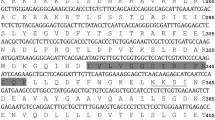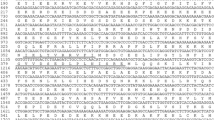Abstract
Heat shock protein (Hsp) genes are stress-related genes that activate the host immune system during infection. Hsp genes expression in fish, studied during bacterial infections, is mostly confined to Hsp70 and Hsp90. The present study is an expression analysis of seven Hsp genes: Apg2, Hsp90, Hsp70, glucose-regulated protein 78 (Grp78), heat shock cognate 70 (Hsc70), Grp75, and Hsp30 during Aeromonas hydrophila infection in rohu, Labeo rohita. Forty-eight rohu juveniles were challenged with 3 × 107 cfu bacteria per 20 g of body weight intraperitoneally. The expression of these genes was studied in infected liver, anterior kidney, and spleen tissues of rohu at different time periods: 0, 1, 3, 6, 12, 24, 48, 72 h, 7, and 15 days post-infection by qPCR. The Hsp gene modulation was greater in liver as compared to spleen and kidney tissues. Induced expression of Apg2, Hsp90, Grp78, Grp75, and Hsc70 was noticed during peak periods (3 to 24 h post-challenge) of bacterial infectivity. Hsp70 was found to be down-regulated during the process of infection. In contrast to the other six genes, Hsp30 showed a variable expression pattern in all three tissues. Grp78 was found to be the most highly (1,587-fold) expressed gene in liver at 12 h post-challenge. Further, molecular characterization of Grp78 revealed it to be a highly conserved Hsp gene, essential not only during infection but also during early developmental stages of rohu, and its expression was noticed in all organs studied except in gill tissues, which indicated its potential immune regulatory role during infection process.










Similar content being viewed by others
References
Ackerman PA, Iwama GK (2001) Physiological and cellular stress responses of juvenile rainbow trout to vibriosis. J Aquat Anim Health 13:173–180
Amemiya CT, Alfo¨ldi J, Lee AP, Fan S, Philippe H et al (2013) The African coelacanth genome provides insights into tetrapod evolution. Nature 496:311–316
Araya MT, Markham F, Mateo DR, McKenna P, Johnson GR et al (2010) Identification and expression of immune-related genes in hemocytes of soft-shell clams, Mya arenaria, challenged with Vibrio splendidus. Fish Shellfish Immunol 29:557–564
Basu N, Todgham AE, Ackerman PA, Bibeau MR, Nakano K, Schulte PM, Iwama GK (2002) Heat shock protein genes and their functional significance in fish. Gene 295:173–183
Basu N, Kennedy CJ, Iwama GK (2003) The effects of stress on the association between Hsp70 and the glucocorticoid receptor in rainbow trout. Comp Biochem Physiol 134:655–663
Carman SM (2002) Special animal abstract for Lepisosteus oculatus (spotted gar). Michigan Natural Features Inventory, Lansing, p 3
Cha IS, Kwon J, Park SB, Jang HB, Nho SW, Kim YK, Hikima J, Aoki T, Jung TS (2013) Heat shock protein profiles on the protein and gene expression levels in olive flounder kidney infected with Streptococcus parauberis. Fish Shellfish Immunol 34:1455–1462
Chen YM, Kuo CE, Wang TY, Shie PS, Wang WC, Huang SL et al (2010) Cloning of an orange-spotted grouper Epinephelus coioides heat shock protein 90AB (HSP90AB) and characterization of its expression in response to nodavirus. Fish Shellfish Immunol 28:895–904
Chuxin WU, Yi L, Meisheng M, Likun W, Chengyu H (2009) Up-regulation of grass carp GRP78 gene expression under heat shock and poly I:C stress. Chin J Appl Environ Biol 15:814–818
Couillault C, Fourquet P, Pophillat M, Ewbank JJ (2012) A UPR independent infection-specific role for a BiP/GRP78 protein in the control of antimicrobial peptide expression in C. elegans epidermis. Virulence 3:299–308
Cui Z, Liu Y, Luan W, Li Q, Wu D et al (2010) Molecular cloning and characterization of a heat shock protein 70 gene in swimming crab (Portunustri tuberculatus). Fish Shellfish Immunol 28:56–64
Das T, Pal AK, Chakraborty SK, Manush SM, Chatterjee N, Apte SK (2006) Metabolic elasticity and induction of heat shock protein 70 in Labeo rohita acclimated to three temperatures. Asian Austral J Anim Sci 19:1033–1039
Das A, Sahoo PK, Mohanty BR, Jena JK (2011) Pathophysiology of experimental Aeromonas hydrophila infection in Puntius sarana: early changes in blood and aspects of the innate immune-related gene expression in survivors. Vet Immunol Immunopathol 142:207–218
Das S, Chhottaray C, Mahapatra KD, Saha JN, Baranski M, Robinson N, Sahoo PK (2014) Analysis of immune-related ESTs and differential expression analysis of few important genes in lines of rohu (Labeo rohita) selected for resistance and susceptibility to Aeromonas hydrophila infection. Manuscript under review in Mol Biol Rep
Dastoor Z, Dreyer JL (2000) Nuclear translocation and aggregate formation of heat shock cognate protein 70 (Hsc70) in oxidative stress and apoptosis. J Cell Sci 113:2845–2854
Deane EE, Li J, Woo NYS (2004) Modulated heat shock protein expression during pathogenic Vibrio alginolyticus stress of sea bream. Dis Aquat Org 62:205–215
Feder ME, Hofmann GE (1999) Hsps, molecular chaperons and the stress response: evolutionary and ecological physiology. Annu Rev Physiol 61:243–282
Forsyth RB, Candido EPM, Babich SL, Iwama GK (1997) Stress protein expression in coho salmon with bacterial kidney disease. J Aquat Anim Health 9:18–25
Gebhardt BR, Ries J, Caspary WF, Boehles H, Stein J (1999) Superoxide: a major factor for stress protein induction in reoxygenation injury in the intestinal cell line Caco-2. Digestion 60:238–245
Haug G, Aktories K, Barth H (2004) The host cell chaperone Hsp90 is necessary for cytotoxic action of the binary iota-like toxins. Infect Immun 72:3066–3068
Henderson B (2003) Chaperonins: chameleon proteins that influence myeloid cells. In: van Eden W (ed) Heat shock proteins and inflammation. Birkhauser Verlag, Basle, pp 175–192
Henderson B, Allan E, Coates AR (2006) Stress wars: the direct role of host and bacterial molecular chaperones in bacterial infection. Infect Immun 74:3693–3706
Kabani M, Martineau CN (2008) Multiple Hsp70 isoforms in the eukaryotic cytosol: mere redundancy or functional specificity? Curr Genomics 9:338–248
Kayhan FE, Duman BS (2010) Heat shock protein genes in fish. Turk J Fish Aquat Sci 10:287–293
Kim SJ, Mitra D, Salerno JR, Hegde RS (2002) Signal sequences control gating of the protein translocation channel in a substrate-specific manner. Dev Cell 2:207–217
Lalitha S (2000) Primer premier 5. Biotech Software Internet Rep 1:270–272
Lee AS (2001) The glucose-regulated proteins: stress induction and clinical applications. Trends Biochem Sci 26:504–510
Lee JY, Cho WJ, Do JW, Kim HJ, Park JW (1996) Monoclonal antibodies raised against infectious haematopoietic necrosis virus (IHNV) G protein and a cellular 90 kDa protein neutralize IHNV infection in vitro. J Gen Virol 77:1731–1737
Livak KJ, Schmittgen TD (2001) Analysis of relative gene expression data using real time quantitative PCR and the 2-∆∆Ct method. Methods 25:402–408
Lu MW, Ngou FH, Chao YM, Lai YS, Chen NY, Lee FY, Chiou PP (2012) Transcriptome characterization and gene expression of Epinephelus spp in endoplasmic reticulum stress-related pathway during betanodavirus infection in vitro. BMC Genomics 13:651
Magnadottir B (2010) Immunological control of fish diseases. Mar Biotechnol 12:361–379
Mohanty BR, Mishra J, Das S, Jena JK, Sahoo PK (2008) An outbreak of aeromoniasis in an organized composite carp culture farm in India: experimental pathogenicity and antibiogram study. J Aqua 16:27–37
Nayak SP, Mohanty BR, Mishra J, Rauta PR, Das A, Eknath AE, Sahoo PK (2011) Ontogeny and tissue-specific expression of innate immune related genes in rohu, Labeo rohita (Hamilton). Fish Shellfish Immunol 30:1197–1201
Pilzer D, Fishelson Z (2005) Mortalin/GRP75 promotes release of membrane vesicles from immune attacked cells and protection from complement-mediated lysis. Int Immunol 17:1239–1248
Quinones QJ, de Ridder GG, Pizzo SV (2008) GRP78: a chaperone with diverse roles beyond the endoplasmic reticulum. Histol Histopathol 23:1409–1416
Reed LJ, Muench H (1938) A simple method of estimating fifty percent end points. Am J Hyg 27:493–497
Roberts RJ, Agius C, Saliba C, Bossier P, Sung YY (2010) Heat shock proteins (chaperones) in fishes and shellfishes and their potential role in health and welfare: a review. J Fish Dis 33:789–801
Robinson N, Sahoo PK, Baranski M, Mahapatra KD, Saha JN, Das S, Mishra Y, Das P, Barman HK, Eknath AE (2012) Expressed sequences and polymorphisms in rohu carp (Labeo rohita, Hamilton) revealed by mRNA-seq. Mar Biotechnol 14:620–633
Rungrassamee W, Leelatanawit R, Jiravanichpaisal P, Klinbunga S, Karoonuthaisiri N (2010) Expression and distribution of three heat shock protein genes under heat shock stress and under exposure to Vibrio harveyi in Penaeus monodon. Dev Comp Immunol 34:1082–1089
Sahoo PK, Mahapatra KD, Saha JN, Barat A, Sahoo M, Mohanty BR, Gjerde B, Odegard J, Rye M, Salte R (2008) Family association between immune parameters and resistance to Aeromonas hydrophila infection in the Indian major carp, Labeo rohita. Fish Shellfish Immunol 25:163–169
Sung YY, MacRae TH (2011) Heat shock proteins and disease control in aquatic organisms. J Aquac Res Dev S2:006
Triantafilou K, Triantafilou M, Dedrick RL (2001) A CD14-independent LPS receptor cluster. Nat Immunol 2:338–345
van der Marel M, Schroers V, Neuhaus H, Steinhagen D (2008) Chemotaxis towards, adhesion to, and growth in carp gut mucus of two Aeromonas hydrophila strains with different pathogenicity for common carp, Cyprinus carpio L. J Fish Dis 31:321–330
Wadhwa R, Taira K, Kaul SC (2002) An Hsp70 family chaperone, mortalin/mthsp70/PBP74/Grp75: what, when, and where? Cell Stress Chaperones 7:309–316
Wang J, Wei Y, Li X, Cao H, Xu M, Dai J (2007) The identification of heat shock protein genes in goldfish (Carassius auratus) and their expression in a complex environment in Gaobeidian Lake, Beijing, China. Comp Biochem Physiol 145:350–362
Yengkokpam S, Pal AK, Sahu NP, Jain KK, Dalvi R, Misra S, Debnath D (2008) Metabolic modulation in Labeo rohita fingerlings during starvation: Hsp70 expression and oxygen consumption. Aquaculture 285:234–237
Yue X, Liu B, Sun L, Tang B (2011) Cloning and characterization of a hsp70 gene from Asiatic hard clam Meretrix meretrix which is involved in the immune response against bacterial infection. Fish Shellfish Immunol 30:791–799
Acknowledgments
The authors are grateful to the Director, Central Institute of Freshwater Aquaculture, Bhubaneswar, India for providing the necessary facilities for conducting experiments. The authors are thankful to the Fish Genetics and Biotechnology Division, CIFA for providing fish for conducting experiments. The Council of Scientific and Industrial Research (CSIR), Government of India is duly acknowledged for financial support to the first author in terms of research fellowship grant (CSIR Sanction no. 9/694(0006)/2013-EMR-1).
Author information
Authors and Affiliations
Corresponding author
Rights and permissions
About this article
Cite this article
Das, S., Mohapatra, A. & Sahoo, P.K. Expression analysis of heat shock protein genes during Aeromonas hydrophila infection in rohu, Labeo rohita, with special reference to molecular characterization of Grp78. Cell Stress and Chaperones 20, 73–84 (2015). https://doi.org/10.1007/s12192-014-0527-2
Received:
Revised:
Accepted:
Published:
Issue Date:
DOI: https://doi.org/10.1007/s12192-014-0527-2




